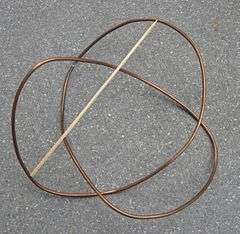Erika Pannwitz
Erika Pannwitz (May 26, 1904 in Hohenlychen, Germany – November 25, 1975 in Berlin[1]) was a German mathematician who worked in the area of geometric topology. During World War II, Pannwitz worked as a cryptanalyst in the Department of Signal Intelligence Agency of the German Foreign Office (German: Auswärtiges Amt) colloquially known as Pers Z S.[2]

Education and thesis
Erika Pannwitz attended the Pannwitz Outdoor School[3] in Hohenlychen until 10th grade, and graduated from Augusta State School in Berlin in 1922. She studied mathematics in Berlin, and also for a semester in Freiburg (1925) and Göttingen (1928). After passing her teaching exam in 1927 (in mathematics, physics, and chemistry), Pannwitz was promoted in 1931 to Dr Phil at Friedrich Wilhelms University with doctoral advisors Heinz Hopf and Erhard Schmidt.[4] Her thesis titled: Eine elementargeometrische Eigenschaft von Verschlingungen und Knoten (An elementary geometric property of entanglements and knots), which appeared two years later in the prestigious journal Mathematische Annalen, was honored opus eximium being considered an outstanding thesis. Both doctoral advisors wrote extraordinary statements about the thesis. Hopf in particular wrote eight pages of comments and left a summary quoted below:
- The author has thus completely solved a difficult concrete problem that has been posed by completely independent investigations; It has achieved this goal by an expedient choice of new concepts, by understanding and profound insight into the difficult material presented to it, by the mastery of older methods and their new uses, and thus proving their scientific maturity in this first essay.
- Since, in my judgment, both the objective scientific value of this work and the subjective performance it achieves exceed the level of good dissertations, I ask the faculty to accept the dissertation submitted by Miss Pannwitz as "eximium".[5]
Schmidt also wrote an extraordinary statement on the thesis:
- I agree with the vote of Mr. Hopf. The topology is one of the most promising yet at the same time most difficult areas of mathematics, because the methodological-technical apparatus is still so in the beginning, that every valuable result can be achieved only with a high mass of strong ingenuity. The present work has enriched the topology with a series of extraordinarily beautiful sentences[5]
In her thesis, she established that every piecewise linear knot in general position (other than the unknot) has a quadrisecant, i.e., four collinear points. The topic was suggested to her by Otto Toeplitz.[6][7]
Later career
In September 1930, Pannwitz became an editor of Jahrbuch über die Fortschritte der Mathematik. From 1940 to 1945, she worked in the cryptography service (with Helmut Grunsky) as part of the war effort. After Germany's defeat in World War II, she briefly held an assistant position at Marburg University. In 1946, she returned to Berlin to work as an editor for Zentralblatt für Mathematik. Travel to work was awkward, especially after the construction of the Berlin Wall in 1961, because she lived in West Berlin and had to pass through checkpoints to reach the Zentralblatt offices in East Berlin. East Germany at that time had mandatory retirement at age 60, which she reached in 1964. From 1964 to 1969 she worked at the Zentralblatt office in West Berlin.[8]
Although Pannwitz had written what was considered an outstanding thesis, throughout her career, she never held a regular academic position. The reasons for this are unknown, but there could have been some element of discrimination, perhaps due to her gender or politics or both.[4][5]
Publications
- Eine elementargeometrische Eigenschaft von Verschlingungen und Knoten., Math. Annalen. Volume 108, 1933, pp. 629–672, online
- With Heinz Hopf: Über stetige Deformationen von Komplexen in sich., Math. Annalen. Volume 108, 1933, pp. 433–465
- Eine freie Abbildung der n-dimensionalen Sphäre in die Ebene. [A free map from the n-dimensional sphere to the plane] In: Mathematische Nachrichten. Volume 7, 1952, pp. 183–185
References
- A different date for her death is recorded in Biographisches Handbuch des deutschen Auswärtigen Dienstes 1871–1945, Band 3 L–R, p. 431 (see Further reading) as November 12, 1975.
- "Foreign Office Cryptanalytic Section" (PDF). NSA. p. 2. Retrieved 3 April 2017.
- Her father was the physician Dr. Karl Pannwitz. The Pannwitz Outdoor School was founded by Dr. Gotthold Pannwitz, see Gründung der Schule im Jahr 1911 Archived 2012-09-05 at Archive.today.
- Weierud, Frode; Zabell, Sandy (6 June 2019). "German mathematicians and cryptology in WWII". Cryptologia. Taylor & Francis: 1–75. doi:10.1080/01611194.2019.1600076. ISSN 1558-1586.
- Vogt, Annette (1999). "Von der Hilfskraft zur Leiterin: die Mathematikerin Erika Pannwitz" [From assistant to head: the mathematician Erika Pannwitz]. Berlinische Monatsschrift (in German). Department Ideals and Practices of Rationality, Max Planck Institute for the History of Science, Max Planck Society. 8 (5): 8–24.
- See footnote on page 629.
- Later the following studies appeared concerning quadrisecants: H. Morton and D. Mond: Closed curves with no quadrisecants. In: Topology. v. 21, 1982, pp. 235–243; Greg Kuperberg: Quadrisecants of knots and links. In: J. Knot Theory Ramifications. v. 3, 1994, pp. 41–50 ; B. Wiest and M. T. Green: A natural framing of knots. In: Geometry & Topology. v. 2, 1998, pp. 31–64 (additivity of the knottedness invariant) and Elizabeth Denne: Alternating quadrisecants of knots (2005) arXiv:math/0510561.
- See also Bernd Wegner: Mathematik-Information im Wechsel der Zeiten und politischen Systeme.
Further reading
- Annette Vogt: Von der Hilfskraft zur Leiterin: die Mathematikerin Erika Pannwitz. In: Berlinische Monatsschrift. Heft 5, 1999, pp. 18–24, online.
- Maria Keipert (Red.): Biographisches Handbuch des deutschen Auswärtigen Dienstes 1871–1945. Herausgegeben vom Auswärtigen Amt, Historischer Dienst. Band 3: Gerhard Keiper, Martin Kröger: L–R. Schöningh, Paderborn u. a. 2008, ISBN 978-3-506-71842-6.